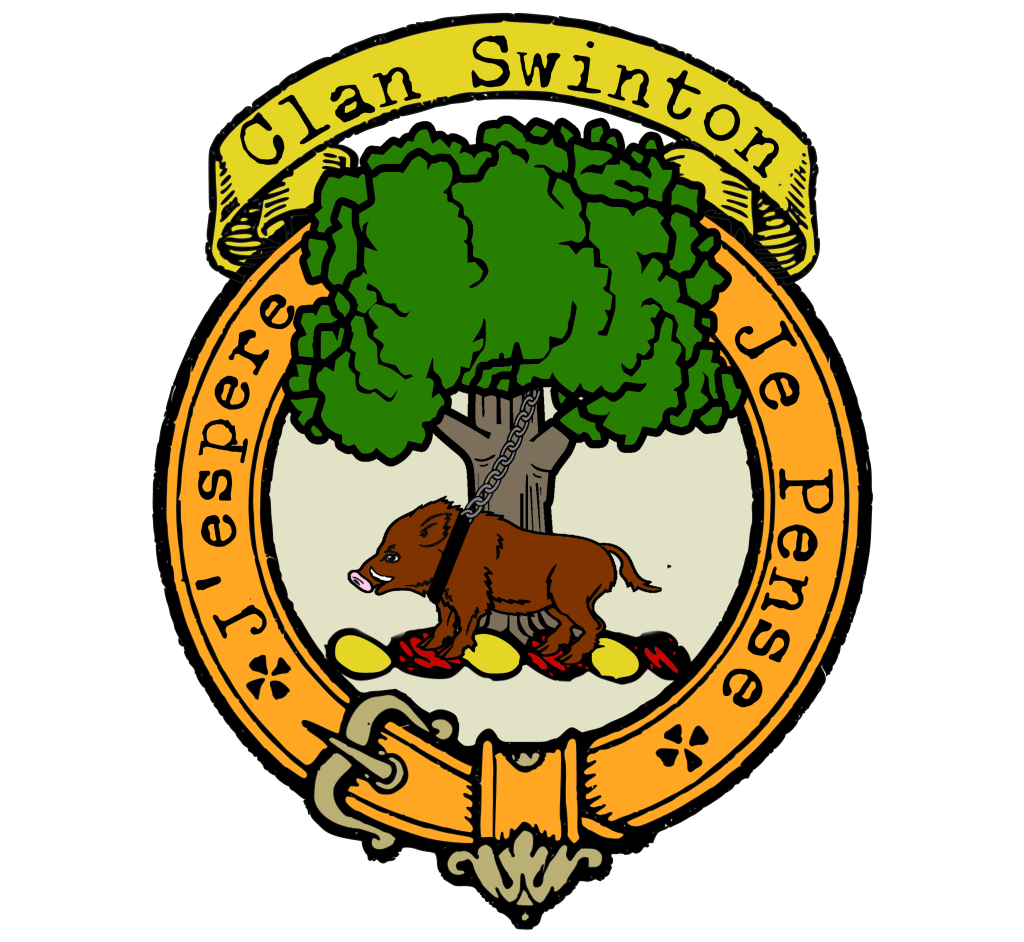Clan Swinton Crest
|
|
CREST: A boar chained to a tree Proper MOTTO: J’espere (I hope) TRANSLATION: I hope VARIATIONS: N/A |
| The Swinton clan’s roots can be traced back to the turbulent times when Scotland and England were not distinct entities as we know them today. Instead, they straddled the border region that would become the historic battleground between these two nations. The name “Swinton” is believed to have several possible origins, one being a nod to the clan’s valor in clearing the region of wild boars—a legend mirrored in their family crest. Another possibility is a territorial connection to the village of Swinewood in Berwick, granted to Coldingham Priory in 1098.
The Swintons’ prominence in the region is attested by their early charters and appearances in historical records. Edulph de Swinton, around 1140, received one of the earliest recorded charters in Scotland, confirming his property at Swinton. This marked the beginning of the clan’s formal recognition and influence. During the tumultuous era of Edward I of England’s reign, Henry de Swinton and his brother William, a priest, pledged their loyalty to the English crown in 1296. This period was marked by shifting allegiances and territorial disputes. Sir John Swinton, a descendant of Henry, emerged as a distinguished soldier and statesman in the reigns of Robert II and Robert III. He played a crucial role in the Battle of Otterburn in 1388, a significant Scottish victory. Sir John Swinton of Swinton, the fifteenth Lord of the name, earned a reputation as a fearless warrior. He was credited with the dramatic feat of slaying the Duke of Clarence, brother of Henry V of England, a moment immortalized in Sir Walter Scott’s poem, ‘The Lay of the Last Minstrel.’ He met his end at the Battle of Verneuil in France in 1424. The Swintons were not only renowned for their military prowess but also for their involvement in political affairs. In 1567, Sir John Swinton joined other Scottish barons in signing a bond of protection for the young James VI, shielding him from the machinations of the Earl of Bothwell. The 17th century brought both adversity and triumph for the Swinton clan. Sir Alexander Swinton became sheriff of Berwickshire in 1640, while his son, Alexander, rose to the Supreme Court of Scotland in 1688 with the title “Lord Mersington.” John Swinton, the eldest son of Sir Alexander, had a tumultuous journey. He was taken prisoner at the Battle of Worcester in 1651, served on Cromwell’s Council of State in Scotland, and later faced trial for treason in 1661. His involvement with Cromwell led to the forfeiture of his estates and imprisonment. The Swinton clan’s fortunes saw a resurgence in the late 17th century when Sir John Swinton, after a successful merchant career in Holland, returned to Scotland. His father’s forfeiture was revoked, and he became a member of both the Scottish and British Parliaments. Over the years, the Swinton clan continued to make significant contributions to Scottish society. Members held titles, served in prominent positions, and made their mark in various fields, including the military and diplomacy. Captain George Swinton, for instance, served as Lord Lyon, King of Arms, and Secretary to the Order of the Thistle from 1926 to 1929. Today, Major General Sir John Swinton, residing at Kimmerghame, serves as the Lord Lieutenant of Berwickshire. The chief of the clan currently resides in Canada, exemplifying the global reach of this remarkable lineage. |
|
Citations:
|
|
Purchase @ Redbubble
Purchase @ Amazon.com
Purchase @ Amazon.co.uk

